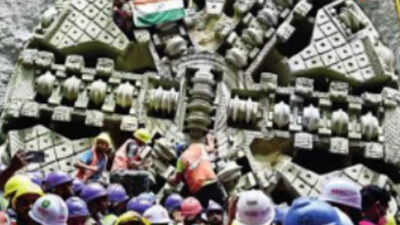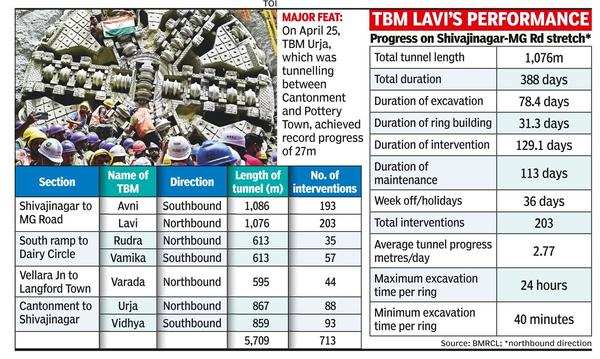Top Searches
- News
- City News
- bengaluru News
- Bengaluru: Namma Metro tunnelling work halted 713 times on 5.7km completed stretch
Bengaluru: Namma Metro tunnelling work halted 713 times on 5.7km completed stretch
Synopsis
Tunnelling through the central business district, between Shivajinagar and MG Road, has been the most challenging in Namma Metro’s Phase 2 underground section so far.

Bengaluru: Tunnelling through the central business district, between Shivajinagar and MG Road, has been the most challenging in Namma Metro’s Phase 2 underground section so far.
The geological conditions forced Bangalore Metro Rail Corporation Limited to suspend boring work 713 times for repair/maintenance of the seven Tunnel Boring Machines which have completed 5. 7km of tunnelling (Shivajinagar-MG Road, South ramp- Dairy Circle, Vellara Junction- Langford Town and Cantonment- Shivajinagar).

This is done mainly when cutter discs are either worn out or suitable ones need to be installed to cut through rocky soil or rocks based on the geological conditions.
“A mix of rocks and soil on the route has ensured that cutter discs need to be changed often when a rock is encountered. These discs are mounted on the cutter head of the TBMs. The number of cutter discs depends on how hard the rock actually is,” explained BMRCL chief engineer (underground) Subrahmanya Gudge.
For instance, 325 cutter discs were replaced in TBM Avni, which was drilled between Shivajinagar and MG Road (1,086m, southbound) in 388 days. TBM Lavi, which was building a tunnel on the same section (1076m, north bound), required 295 discs.
Another official said: “Each cutter disc costs the contractors around Rs 1. 5-3 lakh. But most are beyond repair and often not fit for reuse as they get damaged when they encounter hard rock or boulders in the soil".
“In addition to cutter discs, missing/non-functioning of some parts will also result in the need for discontinuation of boring for maintenance. This will slow down work from 1. 5 days to seven days, depending on the gravity of the situation,” said Gudge.
“Normally, average daily tunnelling is around 2. 4m in mixed conditions/hard rock and 5m in soil/favourable conditions. On April 25, TBM Urja, which was tunnelling between Cantonment and Pottery Town, achieved a record progress of 27m,” said Gudge. However, the average tunnelling progress of TBM Lavi was only 2. 7m a day between Shivajinagar and MG Road (northbound) due to the complex geology. Nevertheless, Phase 2 tunnelling work is progressing well as compared to Phase 1 underground work, which was marred by delays. “We have completed 40% of the tunnelling work so far. We are planning to finish it in another 1. 5 years. Metro operations on the Pink Line will commence by 2025,” added Gudge.
TBM Lavi overcame maximum obstacles
The MG Road-Shivajinagar stretch is part of the city’s longest underground Metro corridor — between Dairy Circle and Nagawara (14km) on the Gottigere-Nagawara section (Pink Line). As many as 713 interventions were required from engineers and contractors for the seven TBMs whenever a maintenance or repair issue cropped up.
Of the seven, TBM Lavi needed the maximum interventions (203). It was followed by TBM Avni (193). Tunnelling between Cantonment and Shivajinagar has also been a complex task. “While TBM Vidhya, which was tunnelling between Cantonment and Shivajinagar (859m, southbound) saw 93 interventions, TBM Urja (867m, north bound) had 88,” said an official.
Similarly, TBM Rudra (northbound) and TBM Vamika (southbound), which drilled 613m each, witnessed 35 and 57 interventions, respectively. TBM Varada that tunnelled 595m between Vellara Junction and Langford Town faced 44 interventions.
The geological conditions forced Bangalore Metro Rail Corporation Limited to suspend boring work 713 times for repair/maintenance of the seven Tunnel Boring Machines which have completed 5. 7km of tunnelling (Shivajinagar-MG Road, South ramp- Dairy Circle, Vellara Junction- Langford Town and Cantonment- Shivajinagar).

This is done mainly when cutter discs are either worn out or suitable ones need to be installed to cut through rocky soil or rocks based on the geological conditions.
“A mix of rocks and soil on the route has ensured that cutter discs need to be changed often when a rock is encountered. These discs are mounted on the cutter head of the TBMs. The number of cutter discs depends on how hard the rock actually is,” explained BMRCL chief engineer (underground) Subrahmanya Gudge.
For instance, 325 cutter discs were replaced in TBM Avni, which was drilled between Shivajinagar and MG Road (1,086m, southbound) in 388 days. TBM Lavi, which was building a tunnel on the same section (1076m, north bound), required 295 discs.
Another official said: “Each cutter disc costs the contractors around Rs 1. 5-3 lakh. But most are beyond repair and often not fit for reuse as they get damaged when they encounter hard rock or boulders in the soil".
“In addition to cutter discs, missing/non-functioning of some parts will also result in the need for discontinuation of boring for maintenance. This will slow down work from 1. 5 days to seven days, depending on the gravity of the situation,” said Gudge.
“Normally, average daily tunnelling is around 2. 4m in mixed conditions/hard rock and 5m in soil/favourable conditions. On April 25, TBM Urja, which was tunnelling between Cantonment and Pottery Town, achieved a record progress of 27m,” said Gudge. However, the average tunnelling progress of TBM Lavi was only 2. 7m a day between Shivajinagar and MG Road (northbound) due to the complex geology. Nevertheless, Phase 2 tunnelling work is progressing well as compared to Phase 1 underground work, which was marred by delays. “We have completed 40% of the tunnelling work so far. We are planning to finish it in another 1. 5 years. Metro operations on the Pink Line will commence by 2025,” added Gudge.
TBM Lavi overcame maximum obstacles
The MG Road-Shivajinagar stretch is part of the city’s longest underground Metro corridor — between Dairy Circle and Nagawara (14km) on the Gottigere-Nagawara section (Pink Line). As many as 713 interventions were required from engineers and contractors for the seven TBMs whenever a maintenance or repair issue cropped up.
Of the seven, TBM Lavi needed the maximum interventions (203). It was followed by TBM Avni (193). Tunnelling between Cantonment and Shivajinagar has also been a complex task. “While TBM Vidhya, which was tunnelling between Cantonment and Shivajinagar (859m, southbound) saw 93 interventions, TBM Urja (867m, north bound) had 88,” said an official.
Similarly, TBM Rudra (northbound) and TBM Vamika (southbound), which drilled 613m each, witnessed 35 and 57 interventions, respectively. TBM Varada that tunnelled 595m between Vellara Junction and Langford Town faced 44 interventions.
FOLLOW US ON SOCIAL MEDIA
FacebookTwitterInstagram
Looking for Something?

Start a Conversation
end of article

